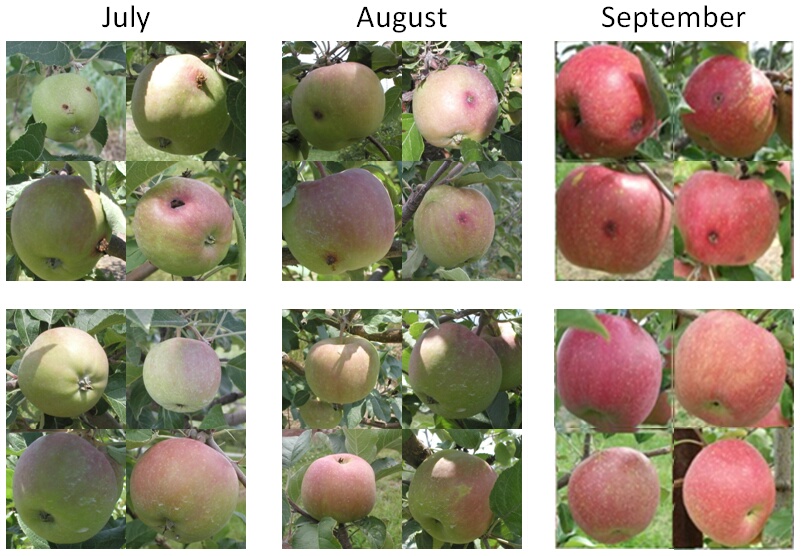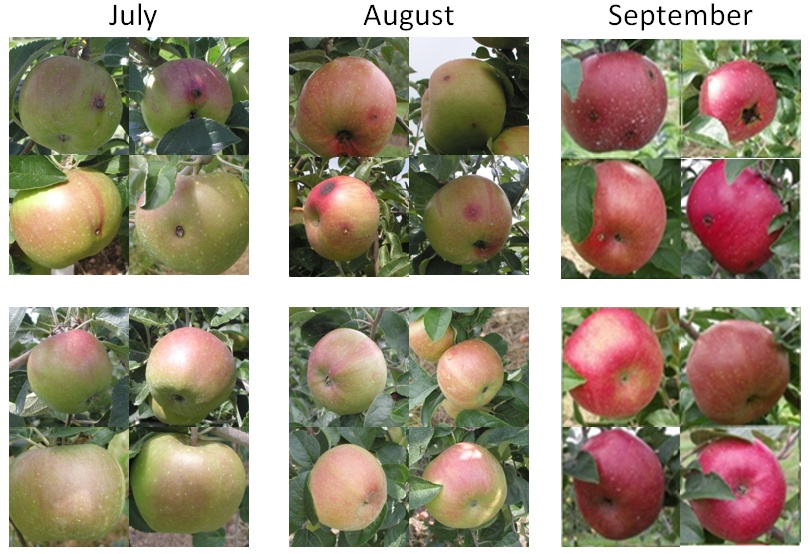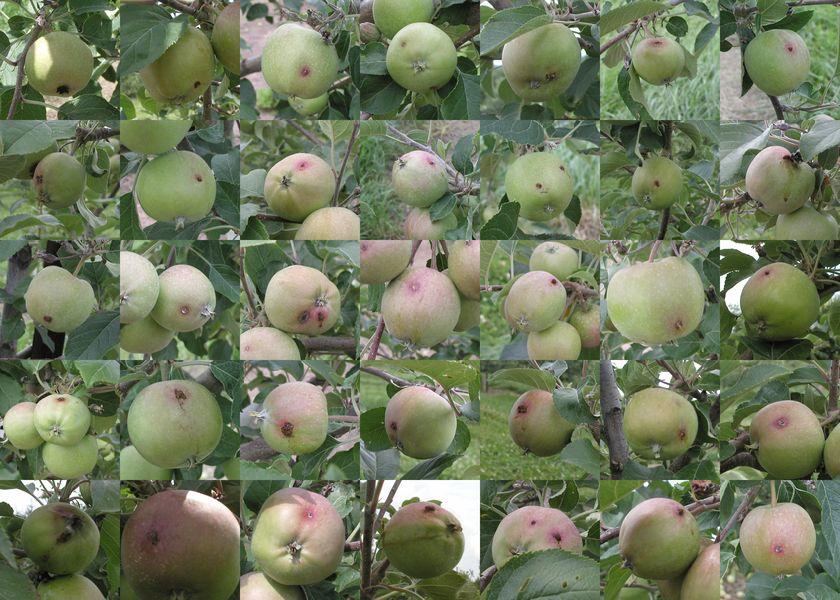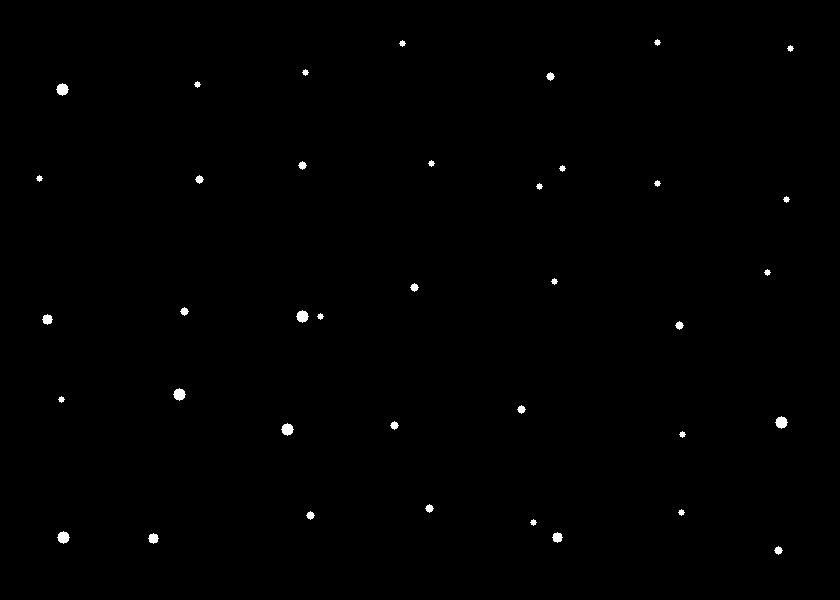
The CASC IFW Database

Overview
Welcome to the
Internal Feeding Worm (IFW) Database of the Comprehensive
Automation for Specialty Crops (CASC) research project. This
project is funded by the USDA Specialty Crop Research Initiative
(SCRI) program under award no. 2008-51180-04876..
Project members at
Purdue University (Guiqin Li, German Holguin, Johnny Park), Penn
State University (Brian Lehman, Larry Hull), and Washington State
University (Vincent Jones) created this database in order to
facilitate the research efforts of developing intelligent algorithms
for automatically detecting apples with internal feeding worm (IFW)
damage.
The database includes
two groups of data, 2009 dataset and 2010 dataset. Over 2,700 apple
images in 2009 dataset, and over 5,800 apple images in 2010 dataset
were collected each year from July to September at the Penn State University
Fruit Research and Extension Center. The images have four apple
cultivars: Fuji, Golden Delicious, Red Delicious, and York. About a
half of the images have apples with IFW damage, and the other half
healthy apples. Table 1 shows the number of apples with IFW damage
and healthy apple images for each cultivar in 2009. Table 2 shows the same data for 2010.
|
|
FUJI |
YORK |
GOLDEN DELICIOUS |
TOTAL |
|---|---|---|---|---|
|
IFW DAMAGED |
493 |
461 |
490 |
1444 |
|
HEALTY |
499 |
430 |
401 |
1330 |
|
TOTAL |
992 |
891 |
891 |
2774 |
Table 1. Number of
images in the database collected in 2009.
|
|
FUJI |
YORK |
GOLDEN DELICIOUS |
RED DELICIOUS |
TOTAL |
|---|---|---|---|---|---|
|
IFW DAMAGED |
836 |
996 |
931 |
1037 |
3800 |
|
HEALTHY |
451 |
601 |
418 |
588 |
2058 |
|
TOTAL |
1287 |
1597 |
1349 |
1625 |
5858 |
Table 2. Number of images in the database collected in 2010.
Each apple in the database is clipped to a 120 by 120 pixels window. Images of apples collected in the same day are assembled into two larger images, one including all the damaged apples, and the other one including all the healthy apples. Image files are named by date (YYYYMMDD), cultivar, and damage condition. For example: 20090701_fuji_damaged.jpg and 20090701_fuji_healthy.jpg
The following image
samples are for (a) Fuji, (b) Golden Delicious, and (c) York
cultivars. The top row shows the images of damaged apples, and the
bottom row the images of healthy apples.

Figure
1 (a) Fuji Variety.

Figure
1 (b) Golden Delicious Variety.

Figure
1 (c) York Variety.
Ground Truth
Ground truth of the
IFW damage is provided in two formats: (1) Plain Text and (2) Binary
Mask Image.
In the Plain Text
format, the file includes the pixel coordinates of the center of IFW
damaged regions followed by the approximate radius of the region. The
ground truth files can be easily identified by the suffix '_gt'. For
example: 20090701_fuji_damaged_gt.txt
is the corresponding ground truth text file for the image
20090701_fuji_damaged.jpg.
In the Binary Mask
Image format, white pixels (i.e., pixels with 255 pixel intensity
value) in the image represent IFW damaged regions while black pixels
(i.e., pixels with 0 pixel intensity value) represent healthy regions
and background. The Binary Mask Images have the suffix ‘_mask’.
For example: 20090701_fuji_damaged_mask.jpg
is the corresponding ground truth binary mask image for
20090701_fuji_damaged.jpg

Figure
2. Raw Image 20090701_fuji_damaged.jpg

Figure
3. The Binary Mask Image for 20090701_fuji_damaged.jpg
How
to Obtain Access to the Database
To obtain a username
and a password for the database, download the license
agreement and
send
a signed copy of the agreement to Somosmita Mitra (somosmita.mitra.1
<at>
purdue.edu). Please, use your institutional email and include a short
note intruducing your self and the institution you belong to.
Once you have
obtained a username and password, click here.
If you have any difficulties with accessing the database, please
email (rvl-webmaster <at> ecn.purdue.edu).